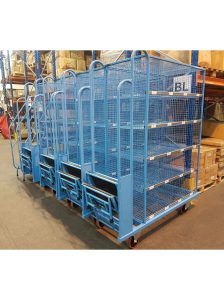Your basket is currently empty!

Warehouses are fast-paced environments. The procurement choices you make can be the key to an efficient day-to-day operation.
One piece of equipment which can make a difference is a picking trolley (https://www.steelyproducts.co.uk/products/picking-trolleys/), which can speed up item storage and retrieval while reducing strain on workers.
This article will assist you in choosing the right picking trolley for your warehouse, outlining the key considerations and fundamental features you should take into account.
Load capacity
The load capacity of a picking trolley refers to its ability to handle the weight of items moved in a facility.
Overloading a trolley can lead to premature wear, reduced manoeuvrability, and safety hazards. That’s why you must select a model with a maximum capacity which comfortably exceeds your standard. Not only is this vital for safety, but it can also help you to maintain desired performance from the trolley over a long period of time.
Durability
Picking trolleys must cope with the daily wear and tear of warehouse usage.
Look for trolleys with reinforced frames made from high-quality materials like powder-coated steel or heavy-duty aluminium. These frames provide long-lasting structural integrity, even under constant use. Also, durable wheels made of rubber or polyurethane offer resistance to cracking, flattening, or damage from uneven surfaces.
Manoeuvrability
In narrow aisles and busy workspaces, picking trollies need manoeuvrability.
Features like swivel casters allow for smoother navigation and tighter turns, especially in small spaces. Choose a trolley with at least two front swivel casters and rear fixed wheels. This will provide a balance between control and directional stability. Ergonomic handles can also help with manoeuvrability as they reduce fatigue for workers, and this makes it easier to push or pull the trolley.
Specific warehouse needs
Every warehouse will have its own unique requirements.
You should look carefully at the types of goods handled, storage layouts, and picking processes.
For example, facilities that pick a high volume of small items may benefit from multi-shelf trolleys, while those handling bulkier goods might need open flatbeds. Consider whether your warehouse needs features like lipped edges to prevent items from falling, adjustable shelving, or space for scanners and labels.
Matching a picking trolley to your environment successfully and this won’t only boost productivity – it also makes the warehouse a safer place to work.
You may also interested in:

The high environmental cost of picking mistakes
Evan Davies, Corporate Marketing Manager of warehouse optimisation software company Lucas Systems, has analysed the environmental cost of picking mistakes in the warehouse.
